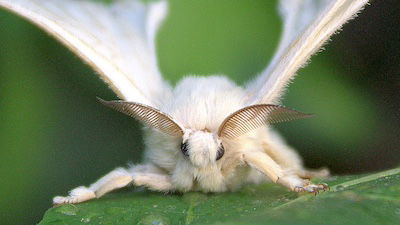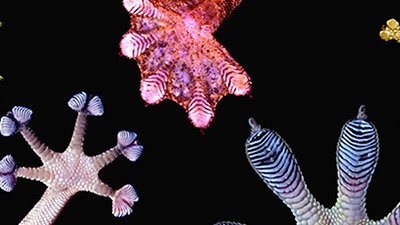
Robotic Insects Mimic God’s Own Design
Energizer bug’s backpack is a battery of God’s own design.
News Source
Micro-air-vehicles (MAVs) have been on the drawing board for years. Tiny flying robots—insect size—can be programmed for search-and-rescue, surveillance, hazard assessment, and explosive detection. By studying insect flight and developing materials to imitate biological structures, some of the problems of aerodynamics and durability have been conquered.
Oddly enough, the toughest problem has been power. “Currently, all these MAV prototypes . . . have a maximum flight time of 5–10 min due to limited battery size,” according to a paper just published in the Journal of Micromechanics and Microengineering.1 Solar panels were tried, but they only operate on sunny days.
Biomimicry is the science of copying designs found in nature. In this case, copying wasn’t enough. For now, it looks like MAVs will need to be hybrids with man’s payloads riding on God’s designs. These “cyborg insect-o-nauts” will hopefully use their own power to take their payloads where man cannot go. The biggest trick is determining how to harness insect energy and use it to power the payload.
“Although we have seen a tremendous and exciting effort in MAV development in the last decade, cyborg insects are much more advantageous when it comes to the aerodynamic performance, flight duration, payload capability, and energy storage at miniaturized scales,” said Ethem Erkan Aktakka of the University of Michigan. “The current technology is simply not there yet to beat nature's evolution over several thousands of years.”
Aktakka’s team has developed a tiny backpack battery for Green June Beetles. The bug should be able to carry two tiny lightweight spiral generators attached at the base of its wings. These generators convert the mechanical energy of wing vibrations to enough electrical energy to power whatever equipment the itsy-bitsy beast carries. The generators are designed to take advantage of a wide variety of vibrations since bugs don’t always flap at the same speed.
We are reminded that even the “simplest” single-celled creatures are far from simple, harboring design secrets put there by our Creator. Here we see a beautiful example of not only “God did it first”—the foundation on which biomimicry truly rests—but also of “God did it so well that people haven’t yet figured out how to copy it.” Millions of years of random evolution didn’t assemble something so intricate that our engineers struggle to copy it; God did.
Micro-air-vehicles (MAVs) have been on the drawing board for years. Tiny flying robots—insect size—can be programmed for search-and-rescue, surveillance, hazard assessment, and explosive detection. By studying insect flight and developing materials to imitate biological structures, some of the problems of aerodynamics and durability have been conquered.
Oddly enough, the toughest problem has been power. “Currently, all these MAV prototypes . . . have a maximum flight time of 5–10 min due to limited battery size,” according to a paper just published in the Journal of Micromechanics and Microengineering.2 Solar panels were tried, but they only operate on sunny days.
Biomimicry is the science of copying designs found in nature. In this case, copying wasn’t enough. For now, it looks like MAVs will need to be hybrids with man’s payloads riding on God’s designs. These “cyborg insect-o-nauts” will hopefully use their own power to take their payloads where man cannot go. The biggest trick is determining how to harness insect energy and use it to power the payload.
“Although we have seen a tremendous and exciting effort in MAV development in the last decade, cyborg insects are much more advantageous when it comes to the aerodynamic performance, flight duration, payload capability, and energy storage at miniaturized scales,” said Ethem Erkan Aktakka of the University of Michigan. “The current technology is simply not there yet to beat nature's evolution over several thousands of years.”
Aktakka’s team has developed a tiny backpack battery for Green June Beetles. The bug should be able to carry two tiny lightweight spiral generators attached at the base of its wings. These generators convert the mechanical energy of wing vibrations to enough electrical energy to power whatever equipment the itsy-bitsy beast carries. The generators are designed to take advantage of a wide variety of vibrations since bugs don’t always flap at the same speed.
We are reminded that even the “simplest” single-celled creatures are far from simple, harboring design secrets put there by our Creator. Here we see a beautiful example of not only “God did it first”—the foundation on which biomimicry truly rests—but also of “God did it so well that people haven’t yet figured out how to copy it.” Millions of years of random evolution didn’t assemble something so intricate that our engineers struggle to copy it; God did.
Further Reading
- Don’t miss the January 2012 issue of Answers magazine. The theme will be “God Invented It First.” The issue will include articles about some fascinating examples of biomimetics, including more about insect flight.
- Get Answers: Design in Nature
For More Information: Get Answers
Remember, if you see a news story that might merit some attention, let us know about it! (Note: if the story originates from the Associated Press, FOX News, MSNBC, the New York Times, or another major national media outlet, we will most likely have already heard about it.) And thanks to all of our readers who have submitted great news tips to us. If you didn’t catch all the latest News to Know, why not take a look to see what you’ve missed?
(Please note that links will take you directly to the source. Answers in Genesis is not responsible for content on the websites to which we refer. For more information, please see our Privacy Policy.)
Footnotes
- Ethem Erkan Aktakka, Hanseup Kim, and Khalil Najafi, “Energy Scavenging from Insect Flight,” Journal of Micromechanics and Microengineering 21, no. 9 (August 12, 2011), doi:10.1088/0960-1317/21/9/095016.
- Ibid.
Recommended Resources

Answers in Genesis is an apologetics ministry, dedicated to helping Christians defend their faith and proclaim the good news of Jesus Christ.
- Customer Service 800.778.3390
- Available Monday–Friday | 9 AM–5 PM ET
- © 2025 Answers in Genesis




